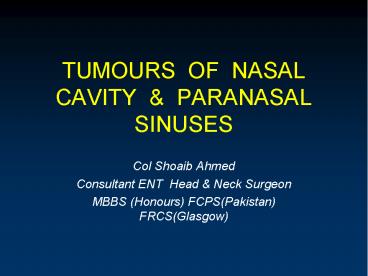TUMOURS OF NASAL CAVITY - PowerPoint PPT Presentation
Title:
TUMOURS OF NASAL CAVITY
Description:
Consultant ENT Head & Neck Surgeon ... Review of Anatomy Paranasal sinuses are air filled cavities that communicate with the nasal cavity There are ... – PowerPoint PPT presentation
Number of Views:198
Avg rating:3.0/5.0
Title: TUMOURS OF NASAL CAVITY
1
TUMOURS OF NASAL CAVITY PARANASAL SINUSES
- Col Shoaib Ahmed
- Consultant ENT Head Neck Surgeon
- MBBS (Honours) FCPS(Pakistan) FRCS(Glasgow)
2
Review of Anatomy
- Paranasal sinuses are air filled cavities that
communicate with the nasal cavity - There are close anatomical relations with orbit
skull base - Cranial nerves 1st, 2nd, 3rd ,4th , 5th and 6th
are in close vicinity
3
Unique Features of Sinonasal Tumours
- Relatively rare of head neck tumours
- Present late
- Large air filled sinuses with no vital
structure in immediate vicinity ? remain
clinically silent - Highly non specific early symptoms
(rhinorrhea nasal obstruction) ? receive scant
attention - Wide variety of pathological lesions
- Extension to anatomically critical areas
- Generally advanced disease with poor clinical
outcome
4
Classification
- BENIGN
- Epithelial
- Inverted papilloma
- Non epithelial
- Fibroma
- Chondroma
- Hemangioma
- Nerve sheath tumour
5
Classification contd.
- MALIGNANT
- Epithelial
- Squamous cell carcinoma
- Adenocarcinoma
- Adenoid cystic carcinoma
- Mucoepidermoid carcinoma
- Olfactory neuroblastoma / Esthesioneuroblastoma
- Non epithelial
- Sarcomas
- Lymphoma
- Giant cell tumour
6
Environmental Factors associated with sinonasal
malignancy
- Wood dust
- Nickel
- Hydrocarbons
- Chromium
- Organic oils
- Isopropyl oil
7
Clinical Features
- EARLY
- Nasal obstruction
- Rhinorrhea
- LATE
- Epistaxis
- Proptosis
- Facial pain / swelling
- Cranial nerve dysfunction
- Trismus
8
How to identify early on ?
- Can be readily mimicked by common respiratory
conditions (e.g. Sinusitis ) - ?
- Unilaterality of symptoms signs
- Persistent progressive symptoms
- No improvement with antibiotics / anti
histamines - Unilateral facial pain / numbness / fullness
- Short span of symptoms suggests a malignant
tumour
9
Clinical Examination
- Thorough ENT head neck examination
- ?
- Trismus
- Orbit
- Neurological exam (cranial nerves 1st to 6th)
- Cervical lymph nodes
10
Diagnosis
- Clinical
- Imaging (X rays, CT , MRI , PET )
- Biopsy
- Always done after imaging
- (highly vascular lesion, or intra cranial)
- Generally under LA
11
Radiological ImagingPlain X rays have lesser
value !
45 degrees Occipitomental projection X ray
PNS
12
Plain X- rays - Findings
- Unilateral findings
- Opaque sinus
- Gross bone destruction
13
CT scans
- Initial investigation of choice
- Shows bony details
- Areas of bone destruction
- Extension into adjacent areas
14
Normal CT scan
Frontal sinus
Ethmoid sinuses
15
CT scan
- Unilateral sinonasal mass
- Bony erosion of lateral nasal wall and skull
base
16
Inverted papilloma
17
Olfactory neuroblastoma in a 14 year old
18
MRI
- Better soft tissue detail
- Useful to detect intracranial extension
- Able to distinguish nasal secretions from
tumour - Indicates extension into dural venous sinuses
19
Positron Emission Tomography (PET scan)
- Routine evaluation for recurrent disease
after primary tumour - Mainly used for squamous cell carcinoma
- Very expensive modality
20
TREATMENT OPTIONS
- Surgery
- Radiotherapy
- Combined surgery radiotherapy
- Chemotherapy
- Palliation
- Lymphomas
21
Olfactory Neuroblastoma in a young lady
22
(No Transcript)
23
(No Transcript)
24
(No Transcript)
25
(No Transcript)
26
(No Transcript)
27
(No Transcript)
28
(No Transcript)
29
CONCLUSION
- These are rare tumours with poor survival are
generally advanced at presentation - Comprise of several histologic types with varying
biological behaviour - Early diagnosis requires being alert for any
persistent unilateral symptoms - Diagnosis is based on CT, MRI and biopsy
- For cure, extensive mutilating surgery followed
by reconstruction is often required
30
- DEPARTMENT OF ENT HEAD NECK SURGERY
- COMBINED MILITARY HOSPITAL
- RAWALPINDI
31
Any Questions ?































